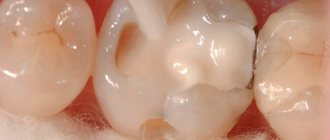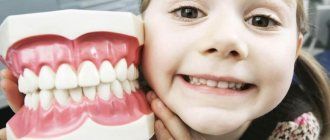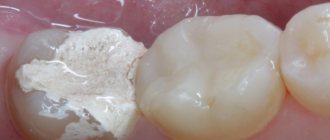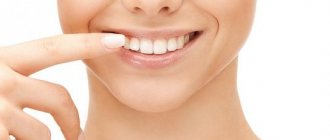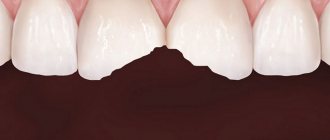During pregnancy, the expectant mother should take care not only of herself, but also of the child, because the health of the child’s teeth can be influenced even before birth.
While waiting for the baby, the expectant mother should eat a balanced diet in order to receive a sufficient amount of vitamins and microelements, and after the birth of the child, breastfeed.
It strengthens the baby's immunity and helps to develop properly. But what to do if, after the appearance of the first teeth, you notice that the enamel on children’s teeth has begun to wear off? The structure of tooth enamel contains calcium hydroxyapatite. Children have a certain supply of calcium from birth, but if it is not enough, the tooth enamel begins to deteriorate.
Tooth wear in children: causes
A child’s teeth wear out for the following reasons:
- congenital abnormal bite;
- bruxism (the child often grinds his teeth in his sleep);
- sensitive and fragile tooth enamel due to certain diseases (hypoplasia, etc.);
- genetic predisposition.
Strong abrasion of tooth enamel is caused by straight and deep bites, leading to accelerated exposure of dentin. One of the reasons for the appearance of malocclusion is disturbances in the development of the jaws, which increases the load on the teeth.
A child’s teeth can also wear out due to systemic diseases that reduce the resistance of body tissues: endocrine disorders, diseases of the central nervous system, etc.
Tooth wear can go through several stages.
Why does tooth loss occur?
Until the 18th century, there was a theory in the world about a worm that ate teeth, destroying them and causing pain. Scientists in Germany, India, China and Egypt seriously claimed that they saw them with their own eyes1. Despite all the naivety of the ancient terminology, this is partly true, because caries is actually caused by living microorganisms, but not worms, but streptococcal bacteria.
Tooth loss occurs as a result of various situations. Conventionally, the reasons can be divided into several groups:
- dental problems: this category includes all diseases that occur in the oral cavity. These are caries, pulpitis, cysts and granulomas, gum inflammation, gingivitis and periodontitis. Any of these problems can be quite easily solved if you consult a doctor in a timely manner. Otherwise, you can lose a once living and healthy tooth,
- chronic diseases of the body: diabetes leads to the destruction of enamel and affects the health of teeth in general, disrupting the metabolism in the body. Osteoporosis is also dangerous for their condition - the disease literally sucks all the calcium from the bones and dental tissues, causing teeth to crumble and fall out,
- natural aging of the body: the older a person is, the greater the likelihood of tooth loss, because with age many health problems appear,
- lifestyle: the presence or absence of bad habits is of great importance. For example, according to statistics, among those who lose teeth in middle age, about 30% are smokers. Participation in dangerous sports that lead to jaw injuries also leaves its mark: football, hockey, boxing. Due to poor oral hygiene and poor nutrition, patients are also forced to seek help from a dentist sooner or later.
Studies have shown that women are more afraid of dental treatment than men. According to statistics, only 45% of the stronger sex are afraid of dental procedures, while 65% of women surveyed are afraid of visiting the dentist2.
What are the dangers of losing teeth?
The peculiar concepts of beauty that existed among our ancestors were noticeably different from those of today. And problems of an aesthetic nature bothered people much less than in our days. However, it should be understood that in addition to the deterioration of external aesthetics, the loss of any number of teeth threatens with other problems:
- indigestion: the quality of chewing food deteriorates, which leads to the development of diseases of the gastrointestinal tract,
- change in bite: displacement, curvature, loosening of healthy teeth occurs, gaps appear in the row,
- violation of the position of antagonists: normally, each tooth has support - lateral and vertical. Due to the hole that has appeared on the opposite jaw, the tooth loses support and will gradually fall out of the hole,
- atrophy and thinning of bone tissue due to lack of chewing load,
- deterioration of articulation and diction: lisp, “swallowing” of some sounds,
- changes in the oval of the face: nasolabial folds worsen, the number of wrinkles increases, cheeks and lips recede - due to the absence of teeth (especially a large number), a person looks noticeably older,
- psychological discomfort: dental problems lead to isolation in communication, the appearance of complexes and decreased self-esteem.
Degrees of tooth abrasion
- Stage I – the enamel of the cutting edges of the child’s incisors and canines and the upper part of the chewing cusps and molars is erased, the dentin is partially affected.
- Stage II – severe abrasion of the chewing tubercles with exposure of dentin tissue.
- Stage III – the height of the tooth crown is reduced to 2/3 of the normal size during wear.
- Stage IV – abrasion of the tooth to the level of the neck. The crown of the tooth is almost completely erased.
If 1 – 2 teeth of a child are worn out, then this is local abrasion; if several teeth or the entire dentition are affected, then this is generalized abrasion.
And then there’s aesthetics
Aesthetic procedures include those that do not affect the functions of teeth, but simply make them attractive. Let's take a closer look at what you can do to improve the appearance of your teeth.
Artistic restoration
This includes masking small cracks, chips, and scratches in the enamel with filling material, if the tooth root is not damaged. Artistic restoration, or, as it is sometimes called, “extension,” is a good way to hide small defects for those who are satisfied with the natural color of the enamel. The color of the aesthetic filling is matched to the color of the remaining teeth, the filling looks natural. But it will no longer be possible to bleach it, so after such a restoration, bleaching is not recommended - the natural enamel will become lighter, and the filling may begin to stand out.
Whitening
If you like the shape of your teeth, there is no fluorosis or other stains on the enamel, but you want to lighten it, whitening is ideal. In a clinical setting, it is completely safe, since all drugs are certified, have been used for a long time and are well studied.
Whitening has virtually no risks; it is a simple and harmless procedure.
Installation of veneers
If the teeth are healthy, the bite is correct, but the patient does not like the natural shape of the teeth (for example, they are too small) or there are noticeable defects in the enamel, then installing veneers will be the solution.
The modern trend in installing veneers is a white, but natural shade and imitation of the texture of natural enamel, so that the teeth do not look “made.”
Veneers that are too white look unnatural
The size of the veneers is selected taking into account the individual characteristics of the patient’s appearance. By selecting the thickness of the plates, you can adjust the shape of the lips (veneers on the front incisors slightly raise the lips, but here it is important to observe the measure, otherwise the result will not be natural), and with the help of the form - the gum line.
There are generally accepted standards for the shape and proportions of veneers, but in each case the doctor selects them individually.
You can literally install from one piece, if this is justified, in order to hide some shortcomings. But the best results are obtained when veneers are installed over the entire smile area (10–12 teeth on top and the same number on the bottom).
Veneers are the best way to hide all dental imperfections
Consistently using all these technologies, anyone can get a perfect smile, regardless of the initial data.
Pathological abrasion: consequences
Pathological abrasion – rapid reduction of enamel and dentin, teeth become shorter, sensitivity increases. How to understand that tooth wear has become pathological, and what could be the consequences?
- The surface of the child’s teeth becomes distorted and destroyed, and the edges of the tooth enamel become sharp. This can injure the tongue, as well as the delicate mucous membrane of the cheeks and lips.
- The height of the teeth changes (if the disease progresses), which leads to malocclusion and deformation of the lower part of the child’s face.
- The position of the temporomandibular joint may change, and this can injure the jaw.
- The sensitivity of tooth enamel increases.
First of all, treatment, not aesthetics
If you are not satisfied with the appearance of your teeth, any changes should begin with a visit to a dental therapist, not an esthetician. While there are functional problems, it is impossible to move on to those procedures that only improve the appearance of teeth.
Therefore, if the teeth are uneven, orthodontic treatment is the first step. Aligners are the most modern way to correct a bite, because they are comfortable and unnoticeable. With them, treatment is not only quick, but also psychologically simple for the patient: there is no need to get used to new restrictions, brushing teeth with the help of special devices, or even the appearance of the structure.
There are no age restrictions for wearing aligners: they can be worn by children from the moment a permanent bite has formed, by teenagers and by adults.
If individual teeth are missing, there are two options:
- In some cases, you can close the gap between adjacent teeth with the help of aligners, form an even and dense row of teeth and do nothing else. If a chewing tooth (5–7th) was missing, then visually it will not be noticeable. But functionally this method is not the best, since the symmetry of the dentition may be disrupted. In addition, this way you can hide the absence of at least one tooth.
- Prepare the site for implantation using orthodontic treatment. Then carry out implantation. The method takes longer, but the result is complete restoration of the functionality of the teeth.
The place for the implant is prepared while wearing aligners.
The treatment procedure is exactly this: first, the bite is corrected, then the implants are installed. Once the implant is installed, the teeth should no longer move. Implants are designed to be installed with correct bite (closure). If the teeth close together in such a way that the load during chewing is distributed unevenly, then the implant will either receive less load or receive excessive load. Both are unacceptable. Any experienced doctor will refuse to place an implant if there is a malocclusion, as he will not be able to provide a guarantee for his work.
First - to the orthodontist, then, if necessary - to the implantologist.
What to do if your child's teeth are worn out
Treatment for tooth wear is developed individually. At the appointment, the pediatric dentist analyzes the causes of the pathology, determines the stage of erasure, the nature of the disease and the characteristics of the development of the child’s body.
What to do if your teeth start to crumble badly
The first thing you need to do is make an appointment with a dentist and come to the appointment. The doctor will conduct an in-person examination and determine the cause of the pathology. Further actions will directly depend on the provoking factor.
If it's all about caries, then it will be filled. To do this, the hole will be closed with modern filling material , which will qualitatively strengthen the walls of the crown. The patient will be told how to properly care for their oral cavity to avoid illness in the future.
If the defect occurs due to mineral deficiency, remineralization is carried out. During the procedure, the crown is treated with a special composition enriched with calcium, phosphorus and other useful compounds. Afterwards, a composite or ceramic veneer is installed to hide the chip.
If you have fluorosis, you should stop using water with a high fluoride content. Existing irregularities can be corrected using dental crowns or inlays. For minor damage, veneers and lumineers will help.
Do you want beautiful dental restoration?
8
or order a free call
Request a call
How the shades of cement were selected during fixation
The work on dental restoration was varied, and we worked with both crowns and dental modules:
- the upper anterior teeth, which were restored using “crown + tooth root” modules, were fixed with double-curing cement,
- and those teeth on which I placed veneers and crowns were fixed with light-curing cement so that in bright daylight the glue would not be noticeable
Light reflecting off the crown or veneers can make the luting cement visible. In addition, due to the fact that the working surfaces of the teeth were of a non-uniform color, with the presence of a yellow tint, it was necessary to work with different colors of cement. That is, I used more yellow cement where the roots of the teeth were and used light-neutral-colored cement on the veneers and crowns to achieve a uniform color scheme. It's very difficult to get the color perfect
.
But we managed to do
:
Naturally, Aryuna is now the most super beautiful:
Aryuna, as I said earlier, works on television, she is a fairly public person - she interviews TV and show business stars. She appears on camera very often, and for her such a smile is not only a guarantee of her good mood, but also great confidence in herself and her abilities. After all, an open and cool smile is the key to female success
! This job, according to her, is the ideal solution for her. Made your smile easy, quick and beautiful!
Aryuna left a video review, short but very charming
:
And in conclusion of my story about this case of restoration of the front teeth, let's once again let's go through all the stages
Aryuna's smile transformation:
- Photo BEFORE the start of
dental restoration. Aryuna came to me with such a smile; she has old temporary structures. - View of temporary structures on the 6 anterior teeth of the upper jaw.
- Temporary structures were removed and teeth and tooth roots were prepared for prosthetics.
- Selecting the color of the veneers.
- New temporary structures were installed. Your smile transformation has begun!
- Aryuna's smile with new temporary structures.
- In the meantime, we prepared the permanent teeth. This is how they “sit” on the model.
- And this is what all the elements of the teeth that we will install for our patient look like
- The teeth have been installed. Close-up - looks great!
- View of a smile on the right
- View of a smile from the left
- FINISH!
ARYUNA'S SMILE WITH NEW TEETH!
Author:
Sergey Samsakov
orthopedic dentist
born 02/02/1989
Education:
2011 — Graduated from the Moscow State Medical and Dental University named after. A.I.Evdokimova
2012 — Internship in the specialty “Orthopedic Dentistry”, Moscow State Medical University named after. A.I.Evdokimova
2014 - Residency in Orthopedic Dentistry, Moscow State Medical University named after. A.I.Evdokimova
If there is nothing left of the tooth
It happens that people put off visiting a doctor for so long that only emptiness remains in place of the crumbling unit. If the roots are preserved, a crown can be installed. If they are absent or are in an unsatisfactory condition for prosthetics, the patient is offered implantation. This is a dental operation during which a titanium pin is implanted into the jaw bone. After its healing, an abutment and an artificial crown are installed on top.
If the client refuses implantation, a dental bridge can be installed. But then you will have to depulp and file the healthy teeth located on both sides of the empty space.
Treat crumbling teeth on time, then you won’t have to spend a lot of time, money and effort on restoring them. At the first symptoms of a destructive process, contact your dentist.




